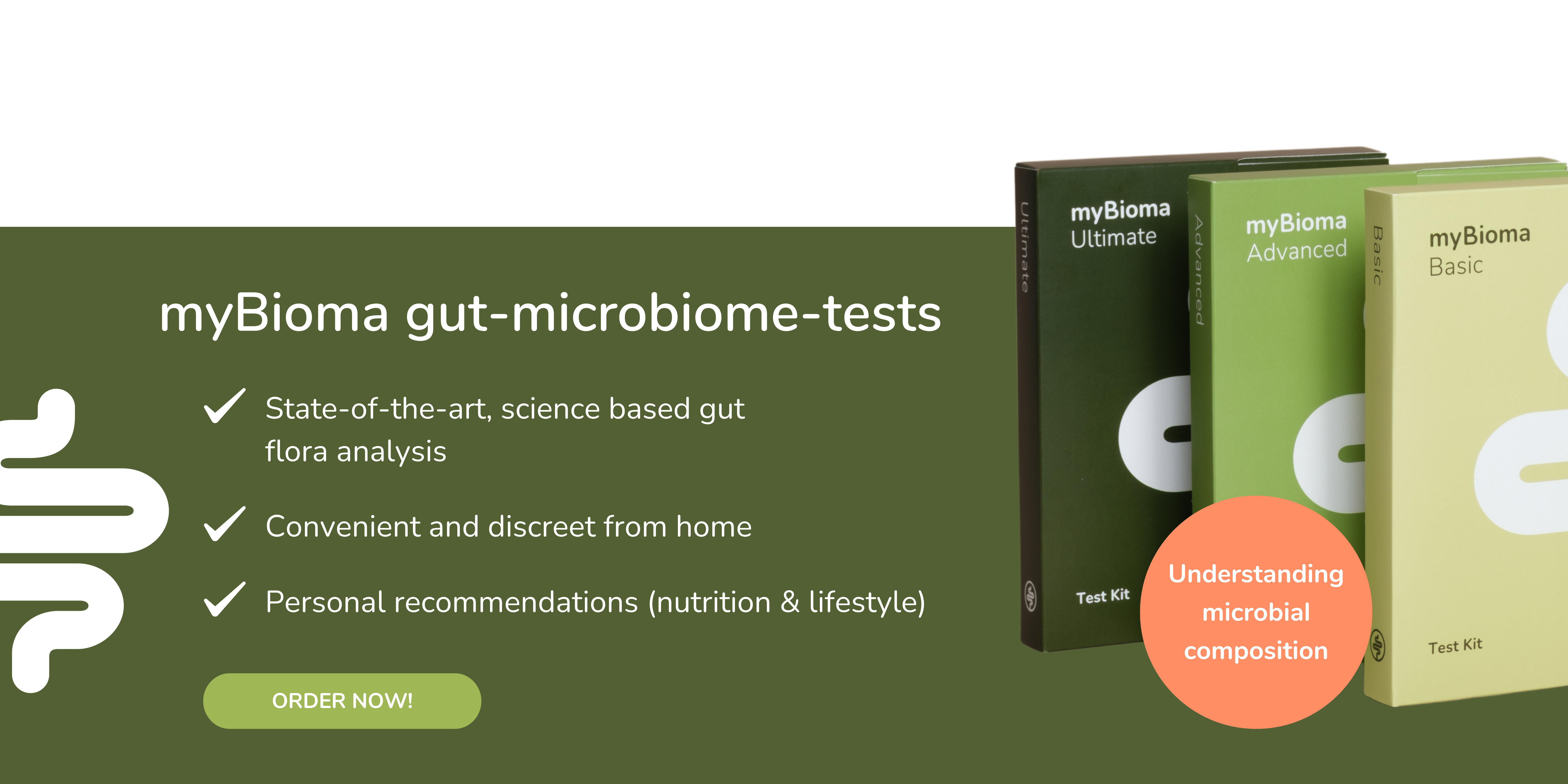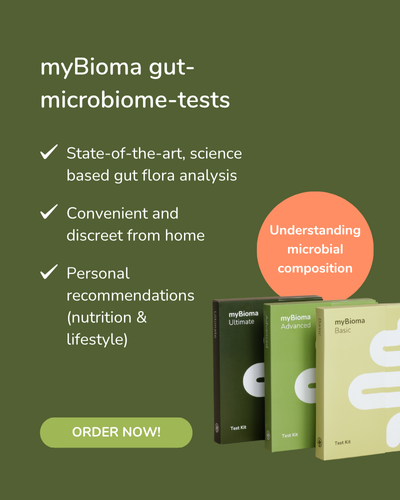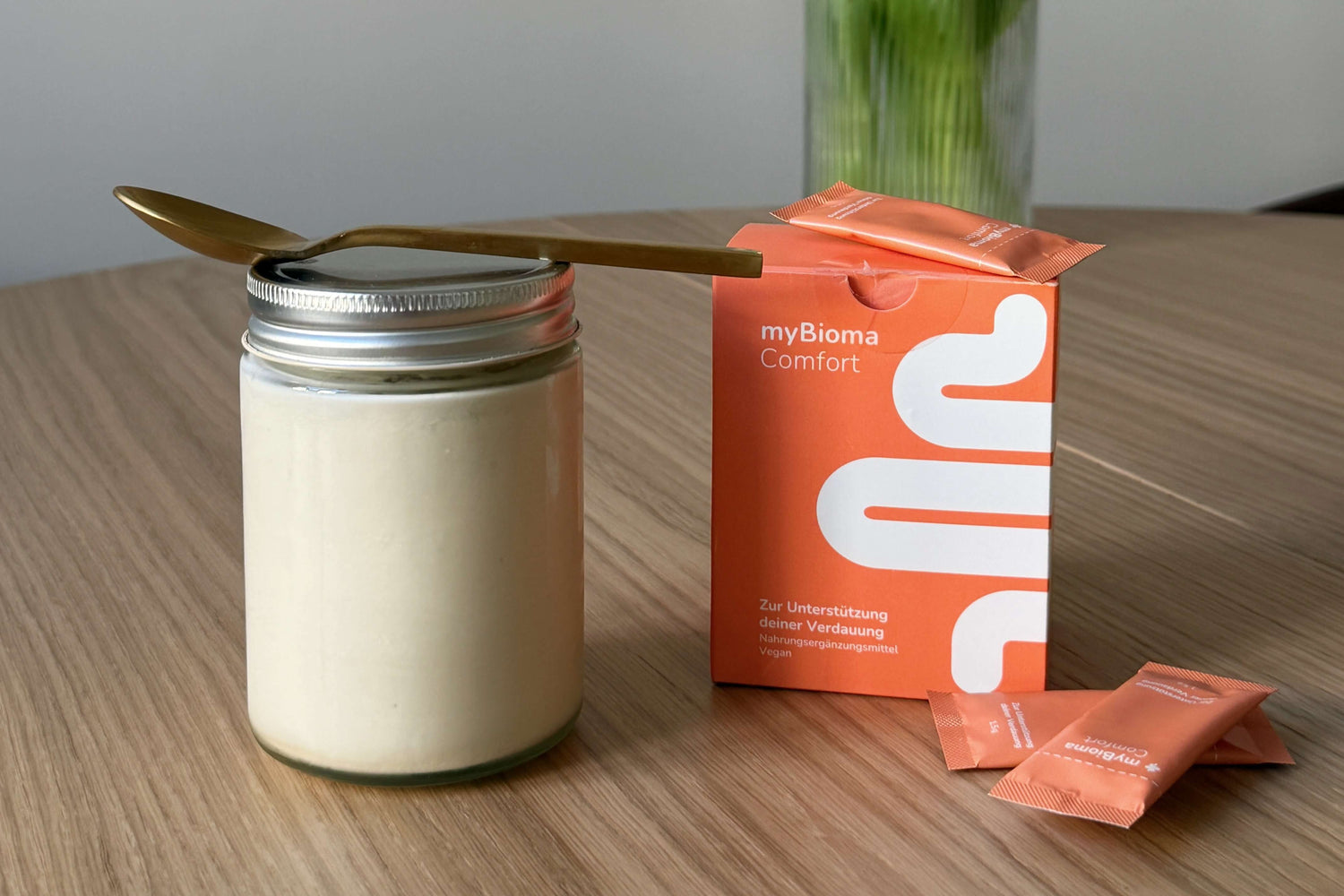Table of contents
- How does blood pressure develop in the body?
- How is blood pressure regulated?
- Risks of high blood pressure – and why low blood pressure is also an issue
- The microbiome as a blood pressure regulator
- Is salt the villain that causes high blood pressure?
- What diet is recommended for high blood pressure?
- How can I support my blood pressure and microbiome with my diet?
- Coffee and blood pressure – friend or foe?
- Probiotics as a source of hope for hypertension?
- Conclusion - Your gut microbiome supports healthy blood pressure
High blood pressure is one of the most serious health problems of our time. Almost one in three adults is affected – often without knowing it. Despite the continuous development of new antihypertensive medications and new treatment methods, society's fight against high blood pressure – and thus against the most important risk factor for cardiovascular disease – remains unsatisfactory (1). The intestinal microbiome (the totality of bacteria in our intestines) is increasingly becoming the focus of research. Surprisingly, but well-documented: The condition of our gut flora can influence blood pressure. This knowledge could open up new avenues for prevention and treatment and provide practical tips for everyday life.
How does blood pressure develop in the body?
Blood pressure is created by the interaction between the heart and blood vessels. The heart acts like a pump: with each beat, it contracts and presses blood into the arteries. This builds up pressure on the vessel walls – this is the systolic blood pressure. When the heart relaxes and fills with blood, a basic pressure remains in the vessels, the diastolic blood pressure. The vessels themselves also contribute to this: the large arteries expand when the heart beats and then contract again so that the blood continues to flow evenly. Small arteries can narrow or widen, thus regulating the resistance in the circulatory system. In this way, the body ensures that all organs are continuously supplied with oxygen and nutrients (2,3).
Systolic and diastolic blood pressure provide information about the strain on the cardiovascular system. Normal values are below 130/85 mmHg. If blood pressure is consistently above 140/90 mmHg, it is considered high blood pressure (hypertension), which increases the risk of cardiovascular disease. Values below 100/60 mmHg, on the other hand, are considered low blood pressure (hypotension) (2).
💡 High blood pressure is more common in men, but after menopause the risk rises significantly in women as well (4).
How is blood pressure regulated?
To keep blood pressure stable, the body has various control mechanisms: Specialised sensors in the neck vessels and the aorta constantly measure the pressure. If it rises or falls, they send signals to the brain and adjust the heart rate and vessel width within seconds to keep blood pressure stable (2). In the medium term, the kidneys also intervene by releasing hormones such as renin, which constrict the blood vessels. Furthermore, the heart produces certain hormones that dilate the blood vessels and promote the excretion of excess salt through the kidneys (5). Even in the long term, the kidneys regulate salt and water balance and thus blood volume.
Everyday factors such as fluid loss through sweating or a high-salt diet can also influence blood pressure – but the body usually compensates for these fluctuations reliably (2).
Blood pressure also changes throughout the day. For example, it rises sharply after waking up and drops again in the evening and at night. Factors such as gender, age, and lifestyle also affect blood pressure. Physical activity such as exercise increases blood pressure because the muscles require more oxygen. Stress, anger, or rage can also noticeably increase blood pressure (2).
💡 High blood pressure only becomes dangerous when it remains high for a longer period or fluctuates significantly. The everyday and usually short-term changes just mentioned are mostly harmless bodily processes and simply demonstrate that the body can react flexibly to different situations.
Risks of high blood pressure – and why low blood pressure is also an issue
Hypertension causes long-term damage to blood vessels, the heart, and kidneys and is considered one of the strongest risk factors for a heart attack or stroke. The causes of hypertension can be diverse and include both genetic and environmental factors. Hyperactivity of the sympathetic nervous system (the "activating, stimulating" part of the nervous system), hormones, stiff or less elastic blood vessels, metabolic problems, and an imbalance of other endogenous neurotransmitters are often involved in its development (1).
Low blood pressure is less often dangerous, but it can cause dizziness, fatigue, and concentration problems (2). The microbiome can be involved in both hypertension (high blood pressure) and hypotension (low blood pressure) – as it can influence blood vessel dilation, nerve impulse conduction, and inflammatory processes. But more on that later!

Also known as the gut-heart axis: The composition of the intestinal flora influences our blood pressure and cardiovascular health.
The microbiome as a blood pressure regulator
In recent years, it has become clear that our gut microbiome plays an important role in regulating blood pressure. Gut bacteria produce metabolites such as short-chain fatty acids (SCFAs), which enter the bloodstream and affect various organs—such as the kidneys, heart, blood vessels, and nervous system. This allows them to influence blood pressure-regulating processes (6). At the same time, studies show that an imbalance in the gut flora (dysbiosis) is closely linked to high blood pressure, and hypertensive individuals exhibit reduced diversity in the gut (6,7). Conversely, existing high blood pressure also appears to influence the composition of the gut flora and can promote an imbalance (6).
The microbiome of a person with hypertension often shows the following patterns (1):
- Dysbiotic (unbalanced) microbiome
- Reduced barrier function of the intestinal mucosa
- Increased number of bacteria that produce potentially harmful substances
- Reduced number of beneficial bacteria and short-chain fatty acids
Through these mechanisms, your intestinal inhabitants can influence your blood pressure:
Short-chain fatty acids (SCFAs)
SCFAs such as acetate, propionate, and butyrate are produced when bacteria in the intestine metabolize fibre. Once in the bloodstream, they exert vasodilatory, anti-inflammatory, and blood pressure-lowering effects, among other things, by binding to specific receptors in the body. Studies of the microbial composition show that people with high blood pressure generally have fewer SCFA-producing bacteria in the intestine. Interestingly, some studies also frequently show increased excretion of SCFAs in the stool in hypertensive patients. It is suspected that this is due to a disturbance in the absorption of SCFAs into the bloodstream – in this case, although an adequate amount of short-chain fatty acids is produced, many are not absorbed into the body and are excreted in the stool (6). In both scenarios, however, this leads to the same initial problem – that too few short-chain fatty acids are available in the body.
Initial experiments in animals or human tissue in the laboratory have shown that direct administration of SCFAs can potentially lower blood pressure (6). This could be an interesting starting point for future therapies for established hypertension – however, further studies, including in humans, are urgently needed.
TMAO and other metabolites
In addition to beneficial SCFAs, intestinal bacteria can also produce metabolites that have a negative impact on blood pressure. Trimethylamine N-oxide (TMAO) is particularly well-studied. Gut microbes convert food components from animal products such as meat, fish, or eggs into trimethylamine (TMA), which is further processed into TMAO in the liver. Chronically elevated TMAO levels are associated with impaired renal function and can influence blood pressure via various hormonal signaling pathways (6).
Other substances such as bile acids or hydrogen sulfide (H₂S), which are produced by the gut microbiome, also affect vascular function and blood pressure regulation. Both substances are generally considered to have vasodilating effects, which can help lower blood pressure. However, the key factor in both cases is the dosage – if the balance is disrupted and an imbalanced gut microbiome leads to either excessive or insufficient production of these substances, the risk of developing high blood pressure may increase (1).
Intestinal barrier and inflammation
Another important piece of the puzzle is the intestinal barrier. If this is weakened by dysbiosis, bacterial components such as lipopolysaccharides (LPS) can enter the bloodstream. This triggers chronic inflammation, which can damage blood vessels and increase blood pressure. Studies show that people with hypertension are more likely to have a compromised intestinal barrier and elevated inflammatory markers (7) .
The gut-brain axis
The gut-brain axis (through which the gut and brain communicate) can also play a role in blood pressure regulation. If this interplay becomes unbalanced, the sympathetic nervous system can become overactive. This system controls, among other things, heart rate and vascular tone – sustained overactivation can thus increase blood pressure and also contribute to the development of hypertension (6).
You can find more exciting information on how you can regulate your nervous system and how your gut health can benefit from it in our detailed blog: Mindfulness, vagus nerve & gut health: How to regulate your nervous system and strengthen your well-being.
💡 It is strongly suspected that, in addition to the factors just mentioned, the microbiome also influences blood pressure regulation through other, previously unknown mechanisms.

Studies suggest that your gut bacteria can influence your blood pressure through several mechanisms.
The Gut Microbiome Test Ultimate shows you how much your microbiome supports your blood pressure regulation and how diverse your gut flora is – helping you to better understand your body. More information about the test’s scope and procedure can be found here: https://mybioma.com/en/collections/microbiome-tests
Is salt the villain that causes high blood pressure?
Salt is always cited as a major factor influencing blood pressure – but does it really play such a big role?
The general answer is yes, salt intake can affect blood pressure. However, people react to it differently. Some are salt-sensitive, meaning their blood pressure rises significantly with higher salt intake due to a genetic predisposition, while others barely react (5). Interestingly, studies also show that this salt sensitivity is more common in women than in men (4).
Recent studies also suggest that changes in the gut microbiota may contribute to salt-induced hypertension (8): For example, excessive salt intake can reduce beneficial bacterial strains such as lactobacilli, which may contribute to hypertension (1). However, the exact mechanisms for this are not yet fully understood.
What diet is recommended for high blood pressure?
When it comes to nutrition and blood pressure, two concepts are particularly in the spotlight: the Mediterranean diet and the DASH diet. Both are well-researched scientifically – and both have their strengths.
The Mediterranean diet is considered a true all-rounder. It relies on plenty of colourful vegetables and fruits, whole grains, legumes, olive oil, nuts, and fish, while red or processed meat rarely appears on the plate. Its secret lies in the combination of fibre and polyphenols – plant-based protective compounds found in olive oil, berries, apples, and nuts. These substances promote a diverse microbiome, inhibit inflammation, and stimulate the production of short-chain fatty acids (SCFAs), which can relax blood vessels and lower blood pressure (9).
The DASH diet (Dietary Approaches to Stop Hypertension), on the other hand, was specifically developed to lower blood pressure. It focuses on fruits, vegetables, whole grains, and low-fat dairy products, and significantly reduces red meat, sugar, and saturated fat. Especially when combined with a low-salt diet, it can have a strong blood pressure-lowering effect—especially in people with hypertension (9).
________________________________________________________________________
Practical checklist for everyday life:
- Daily: vegetables (at least 2 servings), fruit (1-2 servings), whole grain products.
- Several times a week: legumes, nuts, fish, low-fat dairy products.
- Choose fats consciously: olive oil instead of sunflower oil or margarine.
- Reduce salt: Avoid ready-made products, consume sausage and cheese in moderation, and use herbs and spices instead of salt.
- Rare: red meat, sugar, highly processed foods.
________________________________________________________________________
How can I support my blood pressure and microbiome with my diet?
Fibre & prebiotics – food for SCFA-producing bacteria
Our gut bacteria love fibre – it’s basically their “favourite food”. Eating whole grains, legumes, fruits and vegetables regularly provides plenty of nourishment for these microbes. From these fibres, the bacteria produce valuable short-chain fatty acids (SCFAs), which can help relax blood vessels and lower blood pressure. They also contribute to a balanced gut microbiome. Prebiotics (indigestible fibre from foods like onions, garlic, or oats) act like a "super fertilizer" for your gut flora. They provide the good bacteria with exactly what they need to grow and function.
Natural plant substances – little helpers for the intestines and heart
Natural plant compounds, especially polyphenols, are small but effective helpers for the gut and cardiovascular system. They are abundant in foods such as oranges, red fruits, apples, cocoa, olive oil, nuts, and grapes. In the gut, microbes convert polyphenols into smaller, bioactive compounds that then enter the bloodstream, where they can inhibit inflammation, improve vascular function, and thus positively influence blood pressure (1,9).
In addition, polyphenols promote the growth of beneficial gut bacteria. For example, increased levels of Lactobacillus, Bifidobacterium, and Clostridium have been detected with olive oil consumption. Quercetin, a polyphenol found in apples, berries, and red fruits, supports microbiome diversity and can stabilize gut health. Resveratrol from grapes also has a blood pressure-lowering effect. Nuts also contribute to the promotion of healthy gut bacteria and support the production of short-chain fatty acids.
Can foods rich in nitrates and potassium help regulate blood pressure?
The answer here is also yes. Nitrate-rich foods such as beetroot, arugula, spinach, or fennel provide precursors for nitric oxide (NO), a molecule that dilates blood vessels and makes them more elastic. Studies show that just one glass of beetroot juice a day can slightly lower systolic blood pressure in the short term. This effect can be particularly noticeable in people with high blood pressure.
Potassium-rich foods - such as bananas, potatoes, nuts, legumes, or spinach - work through a different, yet equally important mechanism. They help the body excrete excess sodium (salt) and restore the delicate balance of sodium and potassium. This eases the strain on blood vessels and protects the heart and kidneys in the long term.
💡 Practical tip: Regularly consuming fresh vegetables, legumes, and fruit combines both benefits: Potassium regulates salt balance, while nitrate relaxes blood vessels. Even small changes - such as eating potatoes more often instead of white bread, a beetroot salad for lunch, or a handful of nuts as a snack - can help stabilize blood pressure throughout the day.
The integration of foods rich in nitrates or potassium cannot replace therapy for blood pressure, but can be used as a supportive measure.
Coffee and blood pressure – friend or foe?
Coffee can increase blood pressure in the short term, especially in people who drink coffee infrequently. Regular coffee drinkers tend to get used to it, so the effect is less pronounced. Interestingly, studies suggest that moderate consumption (2–4 cups daily) may even be associated with a lower risk of cardiovascular disease - presumably thanks to the high levels of polyphenols and antioxidants in coffee.
However, everyone reacts differently: Some people metabolize caffeine more slowly and react with palpitations or a sharp rise in blood pressure. For others, coffee remains largely unproblematic.
💡 This means: Coffee is not a general taboo for people with high blood pressure – what is important is the amount and individual tolerance.
Probiotics as a source of hope for hypertension?
More and more studies are showing that probiotics (live, beneficial bacteria) not only promote gut health but can also have a positive effect on blood pressure. A meta-analysis of 14 clinical studies with over 700 patients showed that probiotic fermented dairy products can significantly lower blood pressure. What's particularly exciting is that people with high blood pressure often have a less diverse microbiome. Diet plays a key role in this – a high-salt diet, for example, reduces important bacteria like Lactobacillus, which can cause blood pressure to rise. However, if Lactobacillus is administered in a targeted manner, for example through probiotics or probiotic foods, blood pressure can stabilize again (1). However, further human studies are still needed.
Probiotic foods include kefir, sauerkraut, yogurt, kimchi, bread drink, and fermented vegetables.

With the right diet, you can promote healthy blood pressure regulation and a diverse, healthy microbiome.
Lifestyle adjustments for healthy blood pressure and the microbiome
Just a few simple steps can help improve your gut health while also supporting your heart and blood vessels.
Exercise, bodyweight & lifestyle
Regular exercise, such as cycling, walking, or swimming, promotes the diversity of intestinal bacteria and lowers blood pressure (10). A healthy body weight also plays a major role: If you are already overweight, losing just a few kilos can significantly lower your blood pressure.
Relaxation for healthy blood pressure
Chronic stress is a common, often underestimated factor that can increase blood pressure. Therefore, it is especially important to consciously incorporate rest periods into your daily routine. Regular relaxation techniques help to dampen the body's stress reactions, relax the blood vessels, and stabilize blood pressure in the long term. Popular methods include breathing exercises, meditation, yoga, or progressive muscle relaxation. Even a few minutes a day can have a noticeable effect: breathing becomes calmer, the heartbeat more regular, and the body releases fewer stress hormones. Even small routines, such as walks in nature, a hot bath, or listening to music, help reduce stress and relieve the cardiovascular system. Regularly incorporating relaxation into your daily routine not only protects your blood vessels but also improves your overall well-being.
Medications & intestinal health
Blood pressure medications generally work reliably, but can alter the microbiome - which in turn can impair blood pressure regulation. As a result, increasing amounts of medication may be required. Antibiotics can be used specifically to treat existing dysbiosis in the gut and subsequently rebuild the gut flora. However, they carry side effects and require a high degree of personal initiative - for example, through a healthy diet, sufficient exercise, stress management, and good sleep. Their use should therefore always be under medical recommendation and supervision (1).
The oral microbiome and blood pressure
Not only the gut, but also the bacteria in our mouth play a role in blood pressure. Certain oral bacteria convert nitrate from foods like green leafy vegetables into nitrite, which is then processed into nitric oxide (NO). NO relaxes blood vessels and can thus lower blood pressure. Studies show that this effect is lost if the oral flora is disrupted, for example, by strongly antibacterial mouthwashes. A healthy oral flora can therefore also help support the heart and blood vessels (11).
________________________________________________________________________
Small tricks with a big impact on blood pressure
- Alcohol in moderation: A maximum of one small glass of wine or 0.25 l of beer per day - but it is better to avoid it altogether.
- Reduce stress & sleep well: Short breaks, breathing exercises, meditation or walks in nature help to reduce stress and lower blood pressure.
- Avoid smoking: After just one week of being smoke-free, blood pressure drops; after two years, the risk is almost the same as for non-smokers.
- Exercise: Ideally, at least 30 minutes of endurance exercise five days a week. Climbing stairs or taking short walks during the day also supports your heart and gut.
- Oral hygiene: Brush your teeth twice a day and floss at night. Avoid strong antibacterial mouthwashes—just drinking plain water after meals is often enough to protect the good bacteria in your mouth.
________________________________________________________________________
Conclusion - Your gut microbiome supports healthy blood pressure
The microbiome is far more than just a digestion helper: through its metabolic products, it directly affects our blood vessels and, in turn, our blood pressure. Research shows that a balanced microbiome is linked to more stable blood pressure levels. A gut-friendly lifestyle could therefore become an important part of high blood pressure prevention. Even small changes – like eating more vegetables, taking a daily walk and cutting back on salt – can help keep your microbiome in balance and support healthy blood pressure regulation.
Want to be the first to hear about product news, get exclusive discounts, recipes and more? Join our HAPPY GUT CLUB on WhatsApp now: myBioma Happy Gut Club
For you. For your gut.
References
- Yang, Z., Wang, Q., Liu, Y., Wang, L., Ge, Z., Li, Z., Feng, S., & Wu, C. (2023). Gut microbiota and hypertension: Association, mechanisms and treatment. *Clinical and Experimental Hypertension*, *45*(1), 2195135. https://doi.org/10.1080/10641963.2023.2195135
- Stiftung Gesundheitswissen. (n.d.). Blood pressure regulation: What controls blood pressure? https://www.stiftung-gesundheitswissen.de/unser-koerper/blutdruckregulation
- Stimpel, M. (2001). Blood pressure and blood pressure regulation. In M. Stimpel, Arterial hypertension (pp. 3–17). Steinkopff. https://doi.org/10.1007/978-3-642-57617-1_1
- Masenga, S. K., Wandira, N., Cattivelli-Murdoch, G., Saleem, M., Beasley, H., Hinton, A., Ertuglu, L. A., Mwesigwa, N., Kleyman, T. R., & Kirabo, A. (2025). Salt sensitivity of blood pressure: Mechanisms and sex-specific differences. *Nature Reviews Cardiology*, *22*(9), 611–628. https://doi.org/10.1038/s41569-025-01135-0
- Jordan, J. (2015). Pathophysiology of hypertension: What are our current ideas? Der Internist, 56(3), 219–223. https://doi.org/10.1007/s00108-014-3572-0
- Poll, B. G., Cheema, M. U., & Pluznick, J. L. (2020). Gut Microbial Metabolites and Blood Pressure Regulation: Focus on SCFAs and TMAO. Physiology, 35(4), 275–284. https://doi.org/10.1152/physiol.00004.2020
- O'Donnell, J. A., Zheng, T., Meric, G., & Marques, F. Z. (2023). The gut microbiome and hypertension. *Nature Reviews Nephrology*, *19*(3), 153–167. https://doi.org/10.1038/s41581-022-00654-0
- Elijovich, F., Laffer, C.L., Sahinoz, M., Pitzer, A., Ferguson, J.F., & Kirabo, A. (2020). The Gut Microbiome, Inflammation, and Salt-Sensitive Hypertension. *Current Hypertension Reports*, *22*(10), 79. https://doi.org/10.1007/s11906-020-01091-9
- Zambrano, A.K., Cadena-Ullauri, S., Ruiz-Pozo, V.A., Tamayo-Trujillo, R., Paz-Cruz, E., Guevara-Ramírez, P., Frias-Toral, E., & Simancas-Racines, D. (2024). Impact of fundamental components of the Mediterranean diet on the microbiota composition in blood pressure regulation. *Journal of Translational Medicine*, *22*(1), 417. https://doi.org/10.1186/s12967-024-05175-x
- Schunkert, Prof. Dr. med. H. (n.d.). Lowering blood pressure naturally: Six effective everyday tips. German Heart Foundation. https://herzstiftung.de/ihre-herzgesundheit/gesund-bleiben/bluthochdruck/tipps-zu-blutdruck-natuerlich-senken
- Bryan, N. S., Tribble, G., & Angelov, N. (2017). Oral microbiome and nitric oxide: The missing link in the management of blood pressure. *Current Hypertension Reports*, *19*(4), 33. https://doi.org/10.1007/s11906-017-0725-2









